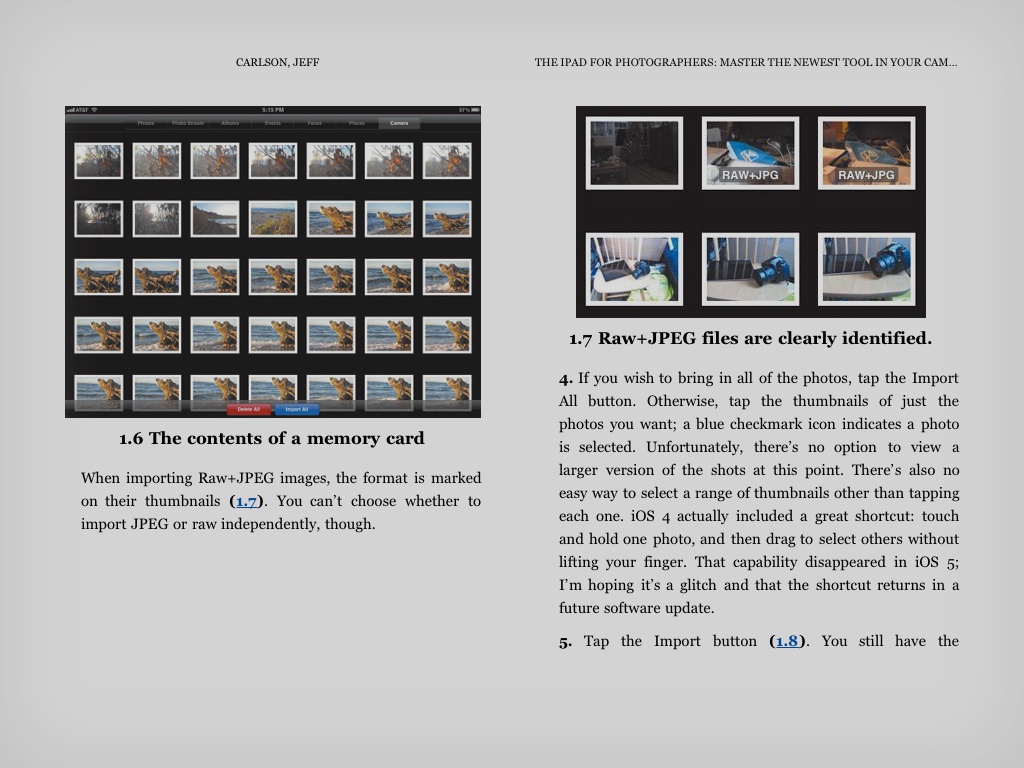Book Review: The iPad for Photographers - Using the iPad as a Digital Studio

AMITIAE - Tuesday 3 April 2012
|
Book Review: The iPad for Photographers - Using the iPad as a Digital Studio |
 |
|
|
By Graham K. Rogers
BackgroundDespite the reduced weight these days, computers are still heavy and have more limited battery capacity than the iPad. With the iPad 2 (and certainly the latest version from Cupertino) the device has matured. It is worth considering instead of a computer. Jeff Carlson's. The iPad for Photographers puts enough information in front of the reader that the idea can become reality.I first saw this work mentioned in a note on Jim Dalrymple's The Loop, which sent me to an Amazon page where I was able to download this work published by Peachpit Press. I had already tried using the iPad a couple of times on the road, rather than carrying the MacBook Pro with me, but I found certain limitations. Reading through the work allowed me to focus on those problems and plan solutions for future trips.
The iPad for PhotographersThe book is clearly set out in chapters each with a separate theme. Each chapter has sub-headings for the separate ideas or (in some cases) apps that are examined. These are all hyperlinked, so identifying a specific area of interest means it is easy for the reader to examine the text and information (images, screen shots, charts, diagrams) related to that concept. Images within the text can be enlarged to full-screen so they may be examined in detail, although there is a slight loss of quality when so enlarged.
The final chapter is followed by an Appendix of apps referenced within the separate chapters and finally a fairly comprehensive index which, like the Contents at the start, was completely hyperlinked. The links to sites were working but although they worked properly in the Kindle app on my Mac, those to the iTunes store did not open when using Kindle on the iOS devices. The publishers are now aware (see below).
CommentsThis is more a reference work than a good read that draws us into a work. Sometimes it is a little repetitious as the instructions for several of the apps that are used, are worked through in detail. The first chapter -- when the principals are set out -- does have a useful dynamic, but overall it is less a read, more a reference work that is to be dipped into: the reader is unlikely to be disappointed. Those chapter and section headings come into good use when using the book for reference.It is the pictures of course that make the difference in any book of photography and Jeff Carlson has some really good examples both as references to his own work and as examples of how the techniques he explains are applied to images. Although he makes several references to, or predictions about the "upcoming" iOS 5 update, which were all correct as far as I could tell, there was no way for him to know of the release of Adobe Photoshop Touch for the iPad, nor of iPhoto, while the book was in preparation. Although he references several other apps that each do an excellent job of editing or adding effects to images on the iPad, I think that these are both game-changers and a book that does not mention them would be incomplete. I wrote asking about these news apps, wondering if a revised edition would be planned. Within a couple of hours he had replied and told me that, indeed, the speed that the book had been produced had meant that, to cover the new information, an addendum had been made available for download for those with the hardcover version. In further discussion, I was told that the publisher is now aware that downloaded versions (such as mine from Amazon) need the information too and that the links to iTunes need to be revised: all is in hand.

The last time I went out with the camera and the iPad, I tried to import some 300 images taken during a couple of hours and was 4.2GB short. With 6GB now free, there is some space to work with. I had already considered my next iPad and I intend to upgrade from 32 to 64GB. There is already a case being made for an even larger version and I would not be surprised to see an iPad with 128GB of space available within the next year. The values of this work are twofold (or more): that users would read and consider the iPad as a workable solution on the road; and in the range of apps discussed (there are others -- he cites 2,600 at the start of Chapter 8) that give ideas to users as to how they may incorporate these and others into their workflows.
Graham K. Rogers teaches at the Faculty of Engineering, Mahidol University in Thailand. He wrote in the Bangkok Post, Database supplement on IT subjects. For the last seven years of Database he wrote a column on Apple and Macs. |
|

For further information, e-mail to

|

|